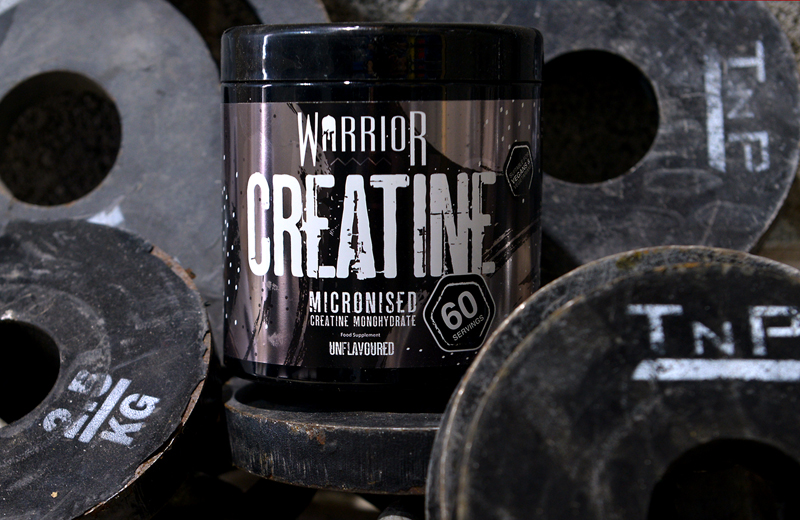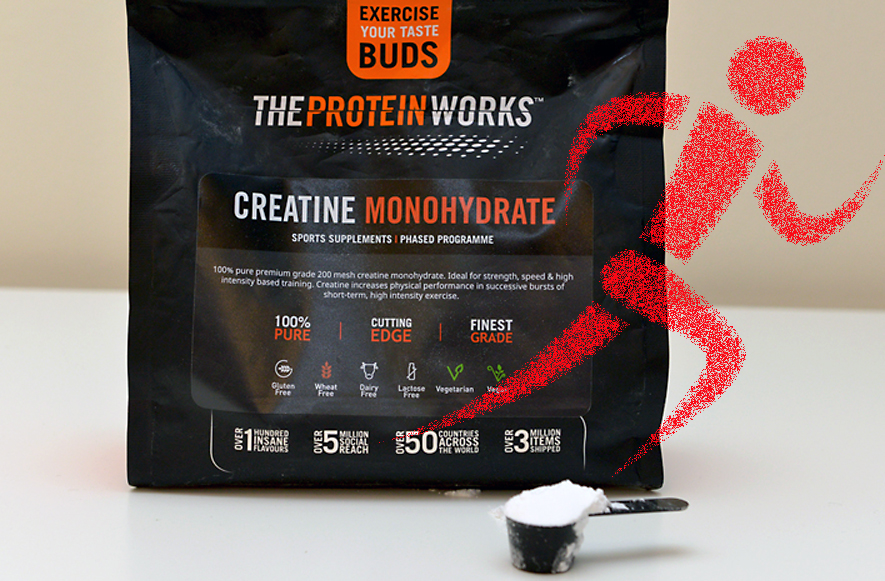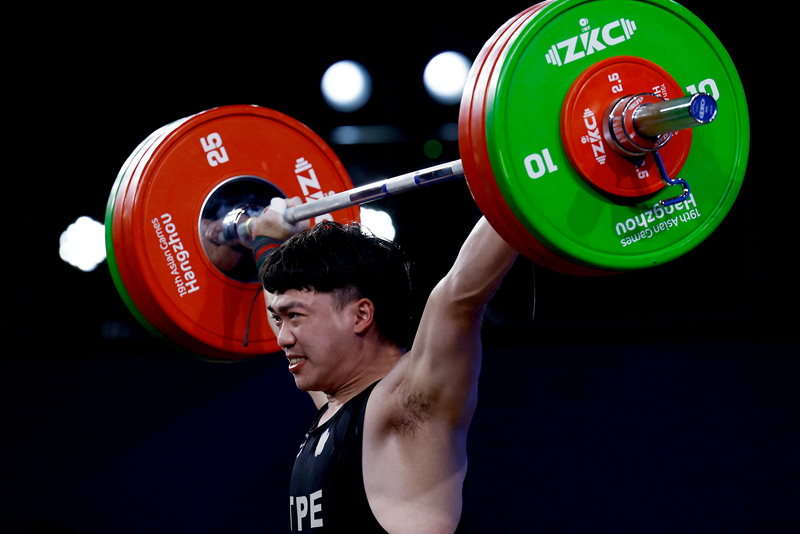Drinks vs. gels: how to choose for maximum performance
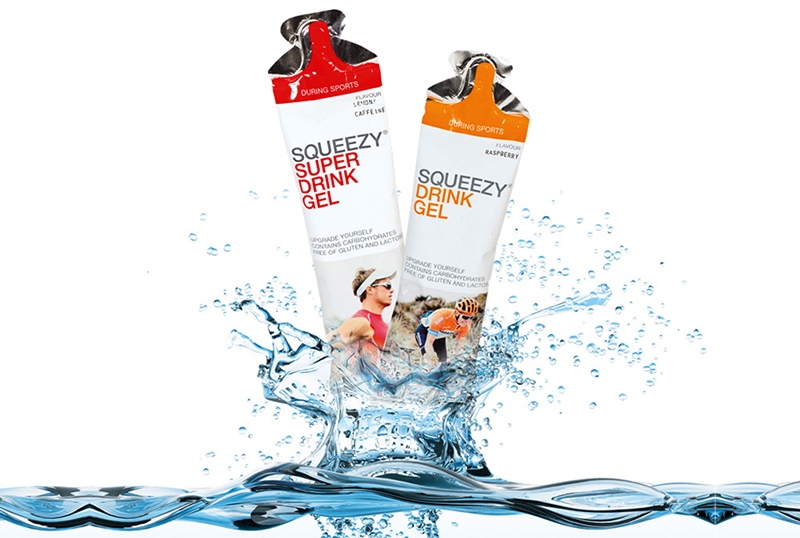
What are the pros and cons of carbohydrate drinks and gels? Andrew Hamilton looks at what the science says and makes practical recommendations
Once upon a time, specialist energy products for athletes such as distance runners and cyclists were virtually non-existent. Arguments raged about whether bananas were superior to malt loaf, or whether cold rice pudding was better than flat Coca Cola! Then carbohydrate drinks arrived. These moved the game on by offering the key nutrients for endurance - carbohydrate and fluid - in a convenient form, which was rapidly absorbed and far less likely to cause nausea or stomach cramps.However, as popular as carbohydrate drinks were, they didn’t tick all of the boxes all of the time. For starters, there’s the faffing around and potential mess of mixing them up before you set off. Then there’s the logistics; water is heavy stuff, and lugging enough carbohydrate drink to fuel a long event is no fun if the race feeding stations only offer water. Perhaps most importantly of all, a lot of athletes also discovered that there’s only so much fluid you can drink for energy without craving something a bit more concentrated – especially in cooler conditions.
Enter gels
Enter the energy gel, which addressed both of these issues at a stroke. The first gels appeared on the market in the late 80s; for example, at the 1988 Hawaiian Ironman Triathlon, Leppin’s ‘Squeezy’ gels (co-developed by running guru Professor Tim Noakes) were distributed to competitors. In the years after their introduction however, gels remained something of a cult product - probably down to the fact that many of the early gel products tasted vile! But over the past 15 years or so, better formulations and manufacturing technology has produced gel products with great taste and texture.Like carbohydrate drinks, gels provide readily and easily absorbed carbohydrate, often with electrolyte minerals too. But because they contain far less water, the carbohydrate in gels is more concentrated and portable. To illustrate this, consider that just 3 gel sachets weighing around 100g in total (and which can easily be slipped in a back pocket or money belt) will likely contain as much carbohydrate as 1kg of carbohydrate drink!
The downside of course is that if you rely on gels for energy replacement, you still need to think about topping up your water/fluid intake, especially in warmer conditions, when sweat losses will add to your fluid replacement needs. Although there’s quite a degree of flexibility in terms of how much water is consumed and when, the ideal solution (no pun intended) is for athletes to consume enough water to produce a reasonable dilution in the gut.
How much water?
The optimum dilution rate varies according to the exact type of carbohydrate consumed and the individual consuming it. However, using research gleaned from studies on carbohydrate drinks as a guide, the most rapid absorption (ie least likely to produce gastric distress such as cramps or bloating) appears to take place with a concentration of around 6-9%, which equates to 60-90 grams of carbohydrate per litre of water in which it’s dissolved. Supposing you consume a 30-gram sachet of gel comprised of 20 grams of carbohydrate and 10 grams of water, this would mean you should consume around 210-320mls of water at or around the time of your gel consumption.However, there’s a lot of flexibility within this additional water consumption figure; during most training sessions, you won’t be pushing yourself flat out so you won’t need maximum absorption rates of carbohydrate from the gut. This explains why your tummy might feel absolutely fine if you ate a slice of fruit cake during a long, steady ride, but leave you in severe distress if you ate the same slice of fruit cake in the middle of a flat out 40km time trial! In other words, when you’re pushing hard for long periods of time, getting carbohydrate absorbed rapidly from the gut and into the working muscles becomes more of a priority.
Gels tolerance
In terms of energy provision, carbohydrate gels do the same job as carbohydrate energy drinks because, apart from containing less water, the ingredients are virtually identical. That being the case, you might assume that there’s no difference in terms of performance when choosing between them. But is that actually the case? In particular, are gels really as easily absorbed and as tummy friendly as carbohydrate drinks?Surprisingly, there’s not a lot of published research on this topic. While some studies have looked at carbohydrate supplementation taken in the form of gels, very few have looked at how gels compare to carbohydrate drinks in terms of user-friendliness. A 2009 study looked at the gastrointestinal (GI) tolerance of high-carbohydrate intakes using gels during intense running in 34 endurance runners(1).
During two separate 10-mile runs, the runners consumed varying amounts of carbohydrate (up to 84g per hour – around the maximum recommended for carbohydrate intake during exercise) exclusively in the form of gels. Overall, the researchers found that, regardless of whether the runners consumed a pure glucose or glucose/fructose gel formulation, the average scores for GI symptoms were at the low end of the scale, indicating ‘predominantly good tolerance’. However, they also pointed out that around 10-20% of the runners experienced serious problems, and that for these runners, individualised feeding strategies might be required.
Osmolality
Were these findings down to an inherent property of the gels or was it simply that some of the runners struggled to cope with the high carbohydrate intake full stop? A 2015 study sought to try and identify whether certain types of gels might be more prone to causing gastric distress(2). The researchers surveyed 31 gel product ranges (incorporating 51 flavour variants) from 23 brands, studied their composition and found some startling variations in carbohydrate amounts and concentrations. The biggest variation however was in something called ‘osmolality’.Without delving into the chemistry, osmolality describes the amount of discreet particles found in a given volume of solution. What’s really important about osmolality however is that high-osmolality solutions have a much greater propensity to draw water towards them. In the tummy, a high-osmolality solution is the last thing you want; by drawing water into the gut, the risk of bloating and other symptoms of gastric distress is greatly increased. In the gels tested above, the osmolality variation was extreme. The lowest-osmolality gel (best) was measured at 303mmols/kg while the highest-osmolality gel scored no less than 10,135mmol/kg – some 30 times higher!! In summary, the researchers concluded: “The large diversity of nutritional composition of commercially available carbohydrate gels illustrate that not all gels should be considered the same.”
Are drinks superior?
We can see that while gels offer some practical advantages, it’s not all plain sailing. Getting the right amount of water at the right time is going to be important to minimise the risk of gastric distress. But the situation is complicated further for athletes with sensitive tummies by the fact that the different formulations used for gels can result in widely differing osmolalities – made more difficult by the fact that such information is not readily available from the manufacturers. Given these facts, are athletes with sensitive tummies better off sticking to conventional carbohydrate drinks? A 2016 study suggests that for some athletes at least, the old-fashioned energy drink could still be preferable(3)Using nine triathletes as test subjects, researchers investigated performance differences between using carbohydrate energy drinks or gels. Each triathlete completed two ‘laboratory triathlons’ consisting of a 60-minute swim, a 180-minute bike ride and a 60-minute all-out run. In one of the trials, the triathletes consumed 67 grams per hour of carbohydrate in the form of a carbohydrate drink. In the other, they consumed exactly the same amount of the same type of carbohydrate from gels. Importantly the amount of fluid provided was matched in each trial – ie extra water was given to the triathletes during the gel trial ensure the total fluid intake was identical in both trials. During the trial, a number of physical measures were assessed along with distance covered during the run and the triathletes’ levels of gastrointestinal discomfort.
The first finding was that the triathletes’ performances during the flat-out run were the same regardless of which energy product they used. However, when it came to comfort, 7 out of the 9 triathletes reported gastrointestinal discomfort (tummy cramps, bloating etc) when using gels. In contrast, not one of the triathletes experience tummy problems when consuming the carbohydrate drink (see figure 1)!
Figure 1: Gastric distress and drink/gel use
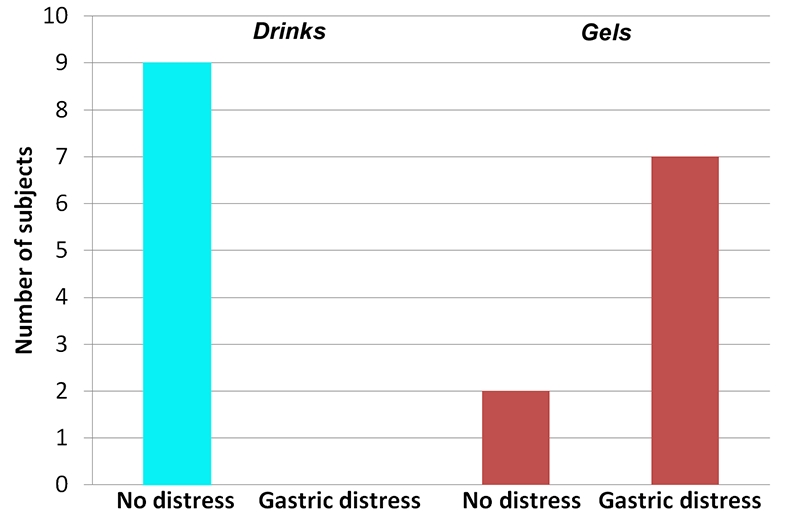
Given that carbohydrate drinks are in essence a diluted form of gel, these are surprising results. One possible explanation is that whereas carbohydrate drink provides a constant concentration of carbohydrate when consumed, consuming gels plus water can result in different (and at times higher) carbohydrate concentrations, depending on the timing of water consumption. Also, the results may have been affected by the precise formulation of the gel – as we said above, characteristics such as osmolality varies greatly and information is not readily available.
Implications for athletes
If you have a sensitive tummy and are prone to gastric distress, especially when consuming relatively high levels of carbohydrate, what should you do? The practical guidance box below provides some useful tips, many of which are equally applicable to those with cast iron tummies too!Practical guidance
Here are some tips based on these findings and best practice generally:- If you have a particularly sensitive tummy, you might find it best to rely on carbohydrate drinks rather than gels for energy replacement.
- If you like using gels however, try experimenting with different brands and types; you may find a lower-osmolality gel, which is easier on the tummy.
- At very high rates of carbohydrate intake (above 80g per hour) carbohydrate drinks may be easier on the tummy than gels regardless of whether you have a sensitive tummy.
- For every 20g of gel carbohydrate consumed (the average content per sachet), aim to consume around 250mls of water.
- If you take gels topped up with plain water, try to consume water with your gels rather than at random times in between gels.
- If you consume all your carbohydrate in gel form, top up with plain water rather than carbohydrate drink (which would supply surplus carbohydrate).
- Like caffeinated carbohydrate drinks, gels containing caffeine are best used sparingly and towards the later stages of a longer event when the fatigue-fighting properties of caffeine are most needed.
References
- Int J Sport Nutr Exerc Metab. 2009 Oct;19(5):485-503
- Int J Sport Nutr Exerc Metab. 2015 Oct;25(5):504-9
- Int J Sport Nutr Exerc Metab. 2016 Apr;26(2):114-22
You need to be logged in to continue reading.
Please register for limited access or take a 30-day risk-free trial of Sports Performance Bulletin to experience the full benefits of a subscription. TAKE A RISK-FREE TRIAL
TAKE A RISK-FREE TRIAL
Newsletter Sign Up
Testimonials
Dr. Alexandra Fandetti-Robin, Back & Body Chiropractic
Elspeth Cowell MSCh DpodM SRCh HCPC reg
William Hunter, Nuffield Health
Newsletter Sign Up
Coaches Testimonials
Dr. Alexandra Fandetti-Robin, Back & Body Chiropractic
Elspeth Cowell MSCh DpodM SRCh HCPC reg
William Hunter, Nuffield Health
Keep up with latest sports science research and apply it to maximize performance
Today you have the chance to join a group of athletes, and sports coaches/trainers who all have something special in common...
They use the latest research to improve performance for themselves and their clients - both athletes and sports teams - with help from global specialists in the fields of sports science, sports medicine and sports psychology.
They do this by reading Sports Performance Bulletin, an easy-to-digest but serious-minded journal dedicated to high performance sports. SPB offers a wealth of information and insight into the latest research, in an easily-accessible and understood format, along with a wealth of practical recommendations.
*includes 3 coaching manuals
Get Inspired
All the latest techniques and approaches
Sports Performance Bulletin helps dedicated endurance athletes improve their performance. Sense-checking the latest sports science research, and sourcing evidence and case studies to support findings, Sports Performance Bulletin turns proven insights into easily digestible practical advice. Supporting athletes, coaches and professionals who wish to ensure their guidance and programmes are kept right up to date and based on credible science.




